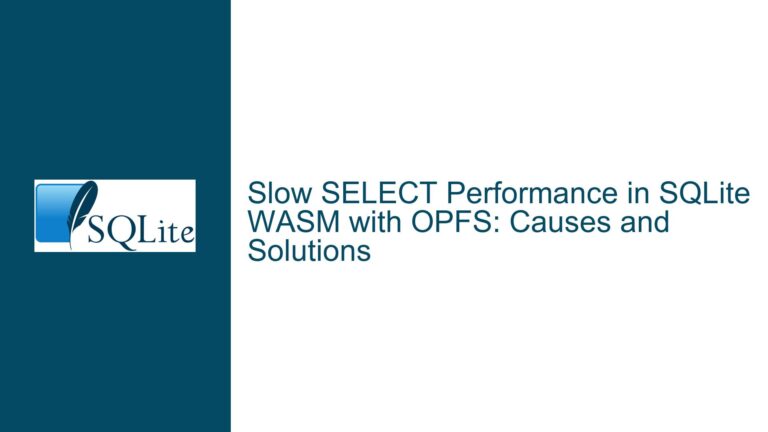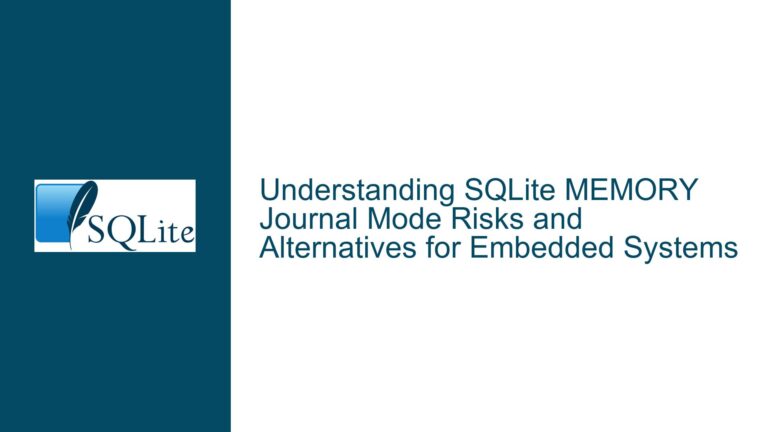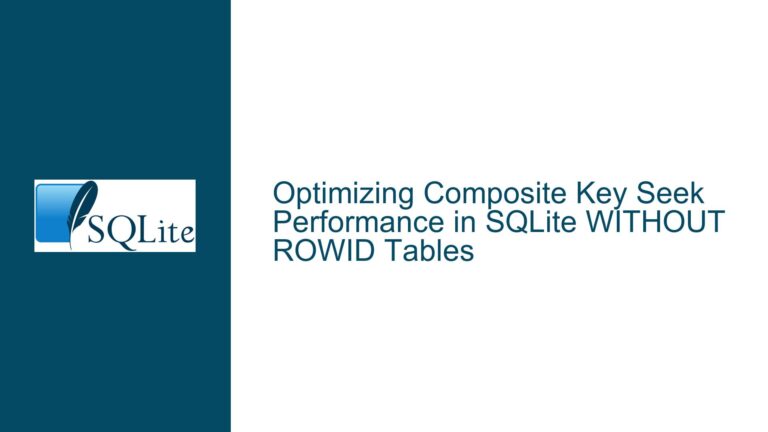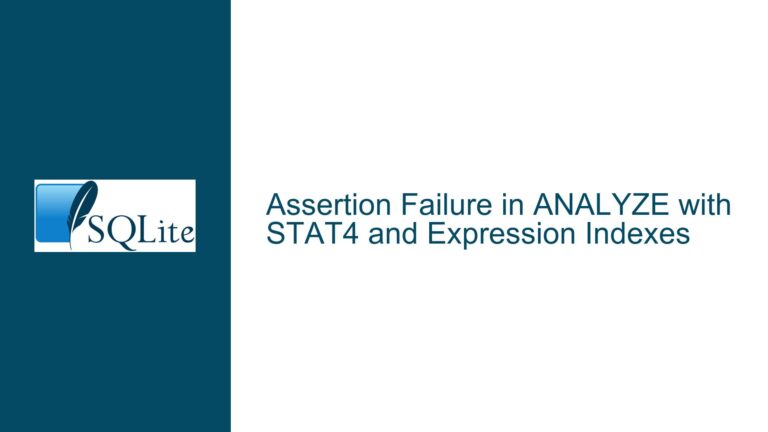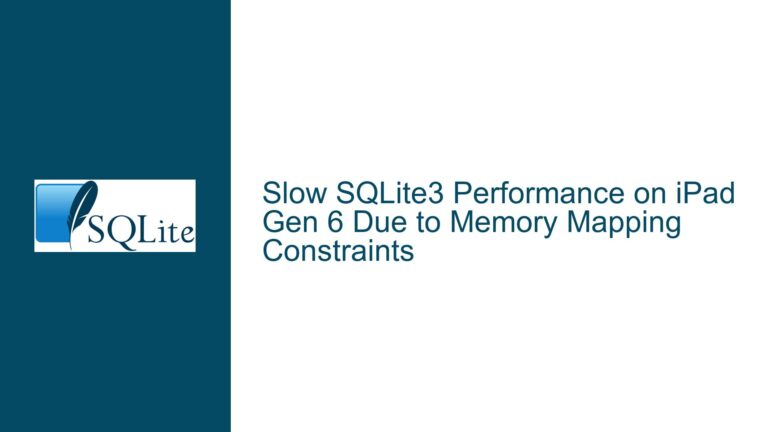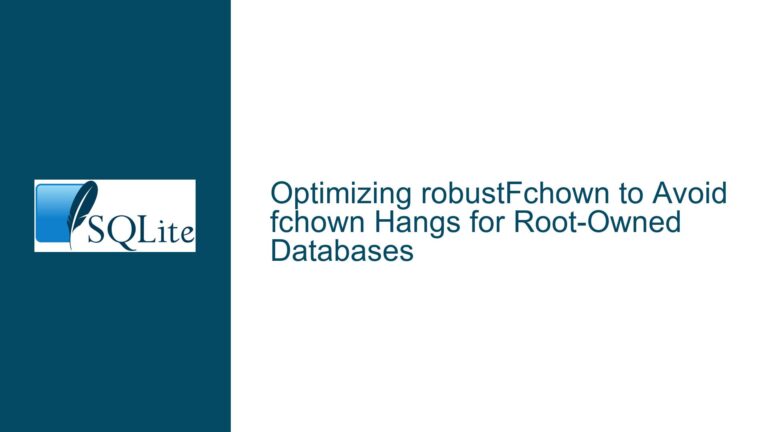Minimizing SQLite for Virtual Table (VTab) Functionality: Challenges and Solutions
Core Components and Dependencies of SQLite Virtual Table Implementations
Issue Overview
The challenge revolves around creating a minimal SQLite build that retains only Virtual Table (VTab) functionality while eliminating all other subsystems (e.g., VFS, B-tree, transaction management). The user’s goal is to reduce the library size to an "absolute minimal" footprint, ideally below 800KB for Linux x64, to integrate SQLite’s SQL interface into a lightweight project. This requires stripping SQLite of components deemed non-essential for VTab operations. However, SQLite’s architecture tightly couples VTabs with core subsystems like the storage engine, query planner, and OS abstraction layer (VFS). For example:
- VTabs depend on SQLite’s parser, tokenizer, and bytecode generator to process SQL statements.
- VTab implementations require the B-tree module to interact with the database schema and manage metadata.
- The VFS layer is necessary even for in-memory databases (e.g.,
memdb) to handle file operations.
Attempts to disable features via compile-time flags (e.g., -DSQLITE_OS_OTHER=1, -DSQLITE_OMIT_*) reduce but do not eliminate these dependencies. The observed binary size of ~800KB reflects SQLite’s irreducible core when retaining VTab support. This stems from architectural constraints: VTabs are not standalone modules but extensions that leverage SQLite’s query execution engine. For instance, executing a SELECT query against a VTab requires the optimizer, virtual machine (for executing bytecode), and memory management subsystems.
Architectural Constraints and Compiler/Linker Limitations
Possible Causes
Inherent Dependencies of VTabs:
Virtual Tables are not independent of SQLite’s core. Even basic operations like registering a VTab (sqlite3_create_module()) require schema management (stored in internal B-trees) and transaction support. Disabling subsystems like the B-tree (-DSQLITE_OMIT_BTREE) would break VTabs entirely.Compiler Optimizations and Dead Code Elimination:
While-DSQLITE_OS_OTHER=1removes default VFS implementations, the application must provide a custom VFS (e.g., for memory operations). If the custom VFS is incomplete or absent, SQLite may retain fallback code paths. Additionally, compiler optimizations (-Os,-flto) and linker stripping (-s) have limits:- Interprocedural Optimization (IPO):
-fltoenables link-time optimizations but cannot remove code that is indirectly referenced (e.g., via function pointers in the VTab structure). - Static vs. Dynamic Linking: Static linking allows dead code stripping, but SQLite’s amalgamation build interweaves components, making granular removal difficult.
- Interprocedural Optimization (IPO):
Misconfigured Compile-Time Flags:
Over-aggressive use of-DSQLITE_OMIT_*flags can create conflicts. For example:-DSQLITE_OMIT_DISKIOdisables disk I/O but is incompatible with-DSQLITE_OS_OTHER=1if the custom VFS requires file operations.-DSQLITE_OMIT_AUTOINITskips automatic initialization but risks runtime failures if the application does not manually initialize SQLite.
Platform-Specific Overheads:
The 840KB size reported for Linux x64 includes platform-agnostic code (e.g., the SQL parser) and platform-specific optimizations (e.g., memory alignment, atomic operations). A 64-bit build inherently includes larger data types and addressing logic.
Strategies for Binary Size Reduction and Custom Builds
Troubleshooting Steps, Solutions & Fixes
1. Validate Compile-Time Configuration
- Review
SQLITE_OMIT_*Flags: Use only flags that explicitly disable features unused by VTabs. For example:-DSQLITE_OMIT_AUTHORIZATION=1 # Disables PRAGMA user_version checks -DSQLITE_OMIT_LOAD_EXTENSION=1 # Removes extension loading logic -DSQLITE_OMIT_WAL=1 # Excludes Write-Ahead LoggingAvoid flags like
-DSQLITE_OMIT_BTREEor-DSQLITE_OMIT_TRANSACTION, which break VTabs. - Enable
SQLITE_OS_OTHERwith a Custom VFS: Implement a no-op VFS for in-memory operations:static int vfsOpen(sqlite3_vfs* pVfs, const char* zName, sqlite3_file* pFile, int flags, int* pOutFlags) { return SQLITE_OK; } sqlite3_vfs_register(&myVfs, 1);This avoids linking the default VFS but requires minimal file operation stubs.
2. Optimize Compiler and Linker Settings
- Size-Optimized Build Flags:
gcc -Os -flto -ffunction-sections -fdata-sections -DSQLITE_OS_OTHER=1 sqlite3.c -Wl,--gc-sections-ffunction-sectionsand-Wl,--gc-sectionsallow the linker to remove unused code sections. - Strip Debug Symbols: Use
strip -s libsqlite3.aor compile with-sto remove debug information.
3. Manual Code Pruning (Advanced)
For extreme size reduction:
- Start with the Amalgamation: The single
sqlite3.cfile simplifies code removal. - Identify VTab Dependencies:
- Keep
sqlite3_create_module(),sqlite3_declare_vtab(), and VTab callback structures. - Retain the SQL parser (
parse.y), tokenizer (tokenize.c), and bytecode generator (vdbe.c).
- Keep
- Remove Unused Modules: Delete code for features like JSON (
json.c), RTrees (rtree.c), and Full-Text Search (fts3*.c).
4. Alternative Approaches
- Embed Lemon Parser: Use SQLite’s
lemonparser generator to create a standalone SQL parser. This decouples SQL processing from the rest of SQLite but requires reimplementing VTab integration. - Use a Lightweight SQL Engine: Consider alternatives like SQLite4’s LSM backend (abandoned but minimal) or sqlean for modular SQL features.
5. Risk Mitigation
- Unit Testing: After manual pruning, validate VTab functionality with tests covering:
CREATE VIRTUAL TABLE t1 USING module_name(arg1, arg2); SELECT * FROM t1 WHERE column = 'value'; - Incremental Removal: Use version control to track code deletions, enabling rollback if regressions occur.
Final Considerations
Achieving a sub-500KB build is feasible with aggressive optimization and manual pruning but requires deep SQLite internals knowledge. For most use cases, the 800KB baseline represents a practical minimum. If binary size is non-negotiable, consider embedding only the SQL parser and reimplementing VTab-like logic without SQLite’s execution engine.

